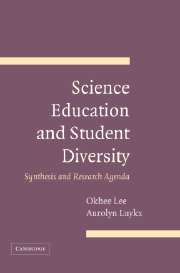Book contents
- Frontmatter
- Contents
- Foreword by Roland G. Tharp
- Acknowledgments
- Introduction
- SECTION I CONCEPTUAL GROUNDING AND POLICY CONTEXT
- SECTION II STUDENT LEARNING AND CLASSROOM PRACTICES
- SECTION III CREATING EQUITABLE LEARNING ENVIRONMENTS
- SECTION IV CONCLUSIONS AND A RESEARCH AGENDA
- Appendix: Method for Research Synthesis
- References
- Index
SECTION I - CONCEPTUAL GROUNDING AND POLICY CONTEXT
Published online by Cambridge University Press: 04 December 2009
- Frontmatter
- Contents
- Foreword by Roland G. Tharp
- Acknowledgments
- Introduction
- SECTION I CONCEPTUAL GROUNDING AND POLICY CONTEXT
- SECTION II STUDENT LEARNING AND CLASSROOM PRACTICES
- SECTION III CREATING EQUITABLE LEARNING ENVIRONMENTS
- SECTION IV CONCLUSIONS AND A RESEARCH AGENDA
- Appendix: Method for Research Synthesis
- References
- Index
Summary
Knowledge of science and technology is an important part of being an educated citizen in the 21st century. As nonmainstream students come to constitute a large fraction of the nation's overall student population, achievement gaps in science among students of diverse cultural, linguistic, and socioeconomic backgrounds are of great concern. While achievement gaps in school science are generally comparable to those in other subject areas, science has not received as much attention from educators and researchers as have core subjects, such as reading, writing, and mathematics. Unlike literacy and numeracy, science is not perceived as a “basic skill”; this trend is reinforced by the fact that current policies of high-stakes assessment and accountability focus mainly on reading, writing, and mathematics. Furthermore, science is often ignored in inner-city schools (where nonmainstream students tend to be concentrated), due to limited funding and resources and the urgency of developing basic literacy and numeracy (National Center for Education Statistics, 1997).
- Type
- Chapter
- Information
- Science Education and Student DiversitySynthesis and Research Agenda, pp. 7 - 8Publisher: Cambridge University PressPrint publication year: 2006



